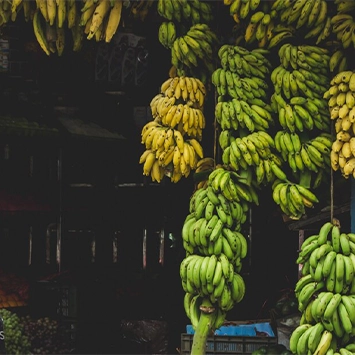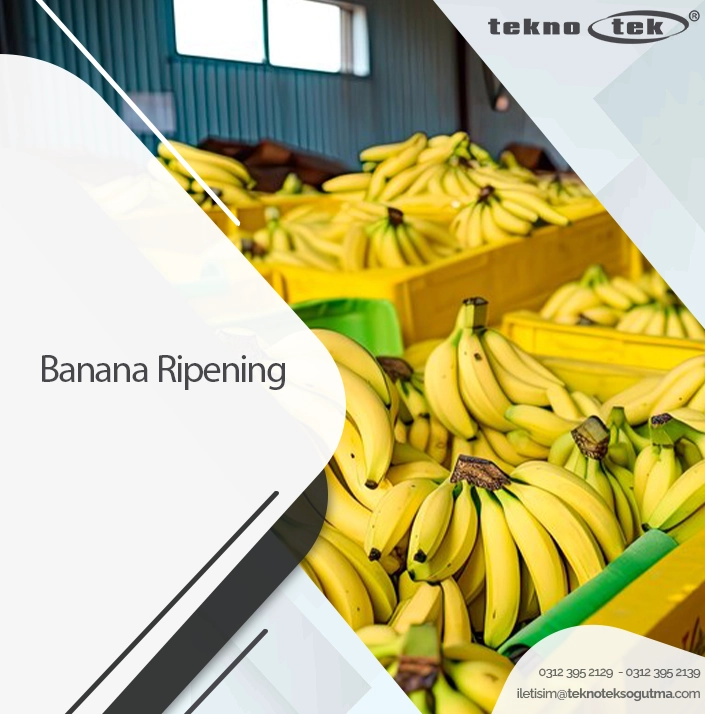Banana ripening method is a process that can be accelerated by exposing the fruit directly to heat or sunlight. In commercial terms, ethylene gas is used, allowing bananas to be controlled during their natural ripening process.
Banana ripening method not only makes the fruit consumable but also affects its aroma and flavor development. Ripe bananas are preferred in many areas. For these reasons, the ripening process is important both in terms of usage and nutritional value.
Cost of a Banana Ripening Room
The banana ripening process is crucial for businesses involved in banana trade and production. This process involves banana ripening and maturation, which is an essential phase.
The cost of ripening rooms used for the ripening process varies depending on specific conditions, such as the size of the facility, the technology used, and its capacity. A ripening facility includes modern rooms equipped with cooling systems, where temperature and airflow are balanced to ensure bananas ripen in a controlled manner.
Stages of the banana ripening process:
Harvesting Green Bananas
- Green bananas are harvested before entering the ripening process.
- They are then carefully packaged to prevent damage.
Transportation and Storage
- Incoming bananas are transported and stored under appropriate temperature conditions. Cooling systems are used to prevent premature ripening.
Classification and Preparation
- Green-colored bananas are classified based on size and quality. Damaged or rotten ones are separated, and only suitable bananas are selected for ripening.
Placement in the Ripening Room
- Selected bananas are placed inside ripening rooms. Proper airflow and stacking arrangement are crucial for effective ripening.
Application of Ethylene Gas
- Ethylene gas is used to accelerate the natural ripening process. The gas must be applied in a controlled manner to prevent excessive or uneven ripening.
Temperature and Humidity Control
- Temperature and humidity are key factors ensuring uniform ripening. Ideal conditions are 15-18°C temperature with 85-95% humidity.
Monitoring the Ripening Process
- Bananas typically ripen in 4-6 days.

After a quality control evaluation, the ripening process is completed, and ripened bananas are packaged for market distribution.
Features of a Banana Ripening Room
The temperature and humidity level in the ripening room must be balanced to ensure proper ripening.
Ethylene gas distribution systems enable controlled exposure of bananas to ethylene, supporting their natural ripening.
Airflow must be evenly distributed to prevent ethylene gas accumulation. Cooling systems prevent bananas from ripening too quickly, ensuring a controlled process. Heating systems maintain the proper environmental temperature.
The rooms must be insulated from external conditions to maintain stable temperature and humidity levels.
Incoming bananas should be systematically placed for effective ethylene gas exposure.
Green bananas should be stacked carefully to prevent damage.
The ripening process should be monitored using modern digital sensors and data analysis tools.
Alarm systems should be installed to prevent excessive ethylene gas buildup.
Banana ripening rooms are essential for controlling the ripening duration, making the process both efficient and safe.
Why is a Banana Ripening Room Necessary?
- Ensures correct and balanced ripening of bananas.
- Provides proper temperature and humidity control.
- Supports fast and safe ripening with ethylene gas.
- Extends banana shelf life.
- Ensures standardized products for commercial use.
- Facilitates transportation and storage.
- Achieves homogeneous ripening through airflow management.
- Allows for ripening independent of seasonal variations.

Banana ripening rooms help maintain quality standards while ensuring fast and efficient ripening, making them essential for commercial banana sales.
Why is the Banana Ripening Process Done?
Bananas harvested for commercial purposes are collected green and ripened before reaching consumers.
The main reason for this process is to control the natural ripening process. If harvested green, bananas take a long time to ripen naturally. Through ripening and maturation, bananas reach the desired ripeness level before being sold.
The ripening process meets market demand, as consumers generally prefer ripe and yellow bananas. Controlled ripening ensures bananas have a uniform color and quality, making them more suitable for sale.
This process also facilitates transportation and storage. When incoming bananas are harvested, cooling systems help extend their shelf life during transit.
Furthermore, temperature and humidity balance plays a crucial role in maintaining quality and durability. Proper regulation ensures that bananas remain fresh for a longer time.
The ripening process provides commercial and industrial advantages. The use of ethylene gas accelerates ripening, making bananas market-ready in a shorter time.
For more information on banana ripening processes and ripening rooms, you can contact Teknotek.

